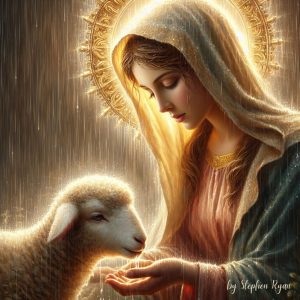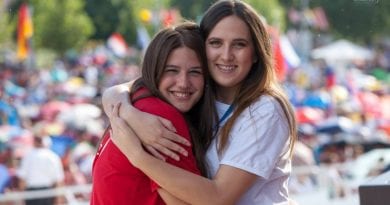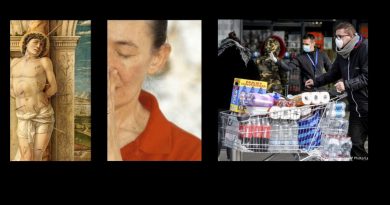Beauty Without Earthly Words…Garabandal Visionaries Describe What Our Lady Looks Like…”There is no woman on earth that resembles the Blessed Virgin.”
What did the Blessed Virgin Look Like?

These are natural inquiries and we all want to know the answers. It helps our devotion and leads us to a greater love for our Heavenly Mother when we can ‘picture in our minds’ how beautiful and loving she is and imagine the sweetness of her voice.
And the descriptions we get from visionaries like young Bernadette of Lourdes, the three shepherd children of Fatima and the four young girls at Garabandal never disappoint us. In fact, the seers always seem to have difficulty imparting the full beauty of their visions.
Someone once asked Conchita, one of the Garabandal missionaries, if she ever saw a statue or picture of Our Lady that looked like her. Conchita simply said, no. Another time, with Conchita, the subject of Our Lady’s first appearance was brought up. At first, she tried to think of something to say and then her mind went back to those glorious events of the past. One could read volumes in the profound expression of inner peace and serenity that momentarily crossed her face as she fell hopelessly silent. Her questioner realized then, that no human tongue could adequately describe the beauty of what she saw.
Impossible though it may be for us to accurately envision Mary now glorified in heaven, the seers, nevertheless, have given descriptions to help us, at least, form a mental picture. Let us, therefore, with the help of various sources, try to recreate as best we can, the image of our beautiful Heavenly Mother as she appeared at Garabandal under the title of Our Lady of Mount Carmel.
Conchita’s Diary
Here is the way visionary Conchita Gonzales described Our Lady in the diary she kept during the apparitions. Conchita was only 12 years old when she wrote the following account:
“The Blessed Virgin appears with a white dress, a blue mantle and a crown of small golden stars. Her feet are not visible. Her hands are wide open with the scapular on the right wrist. The scapular is brown-marron. Her hair is wavy and parted in the middle. She has an oval shaped face and her nose is long and delicate. Her mouth is very pretty with rather full lips. The color of her face is dark but lighter than that of the angel; it is different. Her voice is very lovely, a very unusual voice that I can’t describe. There is no woman that resembles the Blessed Virgin in her voice or in anything else.”
Here we have at least an overall picture of Our Lady as she appeared. As a further supplement, we go to an interview with Conchita conducted by Spanish artist Dona Isabel de Daganzo dated July 2, 1966*.
Q. Would her posture always be the same or did it change? Which posture was the habitual one?
A. Her habitual posture was to look at us with her arms extended, but she would also move them. She would look at the people and sometimes smile-at times more than at other times.
Q. How would you describe her eyes? Did she ever blink or look from one side to the other?
A. Her eyes were dark (Conchita used the word “negros” which actually means black), very sweet and merciful, more toward being large. It seems as though she is not looking at our faces or bodies but rather our souls. I never noticed if she blinked, but she would look from one side to the other.
Q. What was her gaze like? Would she speak to you without looking directly at you?
A. Her gaze is very difficult to describe. It makes one love her more and think more of her. Looking at her makes us completely happy- and her looking at us even more so. When she speaks to us she looks directly at us but she would change her gaze during the conversation.
Q. What was her voice like? Was it a real voice that can be heard through the ears at the same time that the lips can be seen to move, or was it a voice that is heard interiorly but without sound?
A. Her voice, very sweet and harmonious, is heard through the ears. Her words penetrate the heart; it’s as though she puts her voice inside. As she speaks she moves her lips like people do, with sound.
Q. When she spoke, was there any kind of resonance like an echo or did she speak with a clear voice?
A. She would speak with a most clear voice.
Q. Did she ever laugh or would she only smile? If she did laugh, how would you describe it?
A. Sometimes she laughed as well as smiled, but I couldn’t possibly explain her laughter. I will never know how to explain it.
Q. Did she kiss you frequently? Would you girls ask her to kiss you or would she just do it herself? What kind of kisses were they? Did you ever ask her to allow you to kiss her?
A. Yes, she would kiss us almost every day and she would do it. They were good-bye kisses on both cheeks. Yes, I did ask her if I could kiss her and sometimes I kissed her without asking.
Q. What would you feel during the ecstasies?
A. Very great peace and happiness.
Q. What would you feel after the vision?
A. After seeing the Virgin, it was like coming out of heaven (without seeing it) and I would be filled with the desire to love the Hearts of Jesus and Mary and to tell the people about them, for this is the only thing that can make us happy.
In February 1975, in an interview with members of the GARABANDALMagazine staff, Conchita was asked if the Blessed Virgin ever looked sad or if she (Conchita) could ever picture Our Lady crying. The visionary replied that Our Lady never looked sad but always joyful, that her face seemed to be smiling even when she wasn’t smiling. Conchita said that she and the other girls would not have been able to stand to see the Blessed Virgin cry. When asked if Our Lady’s teeth could be seen when she smiled, Conchita answered, yes. We also asked about her voice- whether it was more high than low, however Conchita didn’t fully understand the question. But in her usual concise way, she said that the Blessed Virgin talked, “Just as we’re talking now.”
We cannot expect more from the Garabandal visionaries than the accounts they have given. They are simple, unsophisticated people not prone to giving overly dramatic or flowery descriptions. One senses that they would rather not try to describe the beauty of their visions knowing full well the futility of any attempt.
Although Mary is far more beautiful now that she is glorified in heaven than she was on earth, it might be interesting to hear the account of someone who actually saw her in person. St. Dionysius, after having been converted by St. Paul, was brought by the apostle to see the Blessed Virgin at Jerusalem. St. Dionysius said, when he beheld the Mother of Jesus, that if he had not been prevented from doing so, so great was her beauty, he would have fallen on his face and adored her as God.
As we know, the exterior beauty of Mary is symbolic of an inner beauty overflowing with a super-abundance of all the virtues. There were several incidences at Garabandal where her other qualities became manifest.
Humility
It is difficult for us living today, so tied down with our pride and self-love, to imagine the Queen of all Creation taking the crown from above her head and placing it in the hands of four little children so that they can inspect it, passing it from one to the other, before returning it to her. And yet, this is what Our Lady did at Garabandal.
Motherly Love and Approachability
How much this Heavenly Mother must love her children to permit them, innocent as they most surely were and yet still uncleansed from the faults and failings that burden most children, to kiss her without even asking.
Patience and Tolerance
We also know from the notes of Fr. Valentin Marichalar, pastor of Garabandal during the time of the apparitions, that when the children sensed an apparition was coming to an end, and knowing Our Lady would not leave until they blessed themselves, they would deliberately bless themselves backwards so that she would stay a little longer. And she would stay and bear their childish antics with motherly love and forbearance until they did it correctly.
Fr. Luis Andreu, S.J., who after seeing the Blessed Mother at Garabandal** (the only person other than the four girls to do so), on the drive home in the early hours of the next morning, very quietly and peacefully, passed from this life to the next. The mysterious death of the young priest could be attributed to nothing other than sheer joy. Shortly before expiring he exclaimed, “This is the happiest day of my life!” And then speaking for all of us, Fr. Luis added, “How fortunate we are to have a Mother like that in heaven!”
*AM Santiago, Garabandal 67, Editorial Circulo, Paseo Fernando el Catolico, 39, 7, Dcha., Zaragoza, Spain.
**On August 8, 1961, Fr. Luis saw in a vision, the Blessed Virgin and a preview of the great miracle to come.







According to La Salette visionary Melanie, the beauty of the Blessed Virgin Mary “ravishes the senses.”
But at Medjugorje the BVM appears as a blue eyed white supremacist. With Medjugorje’s brutal Nazi past nothing else would be acceptable to their racist population.